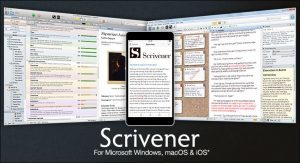Novel Writing Software Scrivener
 Using word to write a novel is like putting a square peg in a round hole
Using word to write a novel is like putting a square peg in a round holeNovel Writing Software Scrivener.
When I was writing my first novel Nothing Left But Fear I began writing it using Microsoft Word.
Word is a great program to use, but it is only great if it is used for what it is designed for.
Word is good for letters, reports, short documents or perhaps short-story book writing, but when you exceed 50-60,000 words (which is the number of words where I think a novel takes form) Word begins to creak around the edges.
You’ll find that it starts to do strange things too, and it may even crash every now and again. This could be my computer though, but I don’t think so.
I also found that as my novel document got larger and larger, I was scrolling up and down to find things and this became tedious for me. After all, novel writing is supposed to be fun…isn’t it?
The scrolling up and down also became quite slow too, as the document size became very large for the computer RAM to deal with…by the way in case you are not a computer geek, RAM is the working memory on your computer.
Finally I’d had enough…so what did I do?
I turned to good old Google to search for Novel Writing Software and what came up? Scrivener did. An ideal piece of software for both Indie Authors and novelists writing for a publishing house.
 Novel Writing Software Scrivener
Novel Writing Software ScrivenerWhat is good about Scrivener?
The first good thing about Scrivener is that it is designed for writers and for writing novels, along with other creative written forms, like screen plays.
You can split your novel (or screen play) into the various chapters and characters, which for me makes it so much easier to find things, to update and write your novel (especially as it gets larger in words) or amend your masterpiece.
My final debut novel was first published in Kindle format and Scrivener handled this. The document was output in the correct format, including the cover image and all the other parts of the novel needed by Amazon. The cover had to be designed outside of Scrivener and then imported to form part of the overall document.
It did take a few goes at getting it right though. I will say that I find this part of the software a little confusing and perhaps not as straight forward as I’d like it to be. However, I got there in the end.
What about a paperback novel?
When I turned to publish my novel in paperback form, Scrivener came in to its own once again. Using the export function once again, only this time setting my novel script up for paperback output, Scrivener did all the hard work for me.
For my initial paperback I used Createspace to print my novel and Scrivener was able to output the pages in the correct format and with the correct page pagination etc.
I did however, have a slight problem to begin with whereby I’d output the document with my ‘odd page numbers’ falling on the left instead of on the right. However, with a few tweaks, this got sorted out very easily.
What are the other output types?
With Scrivener you can export your finished document to a wide variety of file formats, which funnily enough includes Microsoft Word. You can also export as a RTF, PDF and HTML file to make it easy to share your work with others. Or as I did self-publish by exporting to ePub or Kindle* formats to share your work via iBooks or Amazon, or for reading on any e-reader.
Character names
Coming up with original character names I find a bit of a struggle sometimes. However, Scrivener has a built in name suggestion tool (or name generator) for both first names and surnames.
The name suggestion tool for your novel characters even has a country setting, so you can choose names associated with a particular region.
Chapter collections
One of the main benefits Scrivener has over software like Word is what it refers to as ‘Collections’. This is the feature that transformed my book writing.
When for example you are writing chapters from a character perspective and then jump to new chapters, you can group the related chapters together into collections. This I find invaluable, especially in the way that I write. I tend to write each character from beginning to end, whilst inserting relevant breaks (or chapters). I then splice the story together, bringing each of the characters together, which I’ve written separately.
This is how I styled my book with cliff-hanger chapter endings, by using Scrivener which made my job much easier.
 The End of article on novel writing software
The End of article on novel writing softwareIt’s very easy to move a chapter(s) up or down in your script. This feature is useful if you change your mind about the order of how things happen within your story. This is especially true for me, as I build my story and plot as I construct my novel.
You can also see all of the chapters in one ‘Collection’ associated with a particular character, so you can check the consistency from one chapter to the next with ease.
Other program features
Within Scrivener there are many other features which I’ve yet to workout or use. But even with the limited features that I’ve so far used, I would definitely recommend this program as great novel writing software.
The post Novel Writing Software Scrivener appeared first on ADRIAN RUSSELL.



